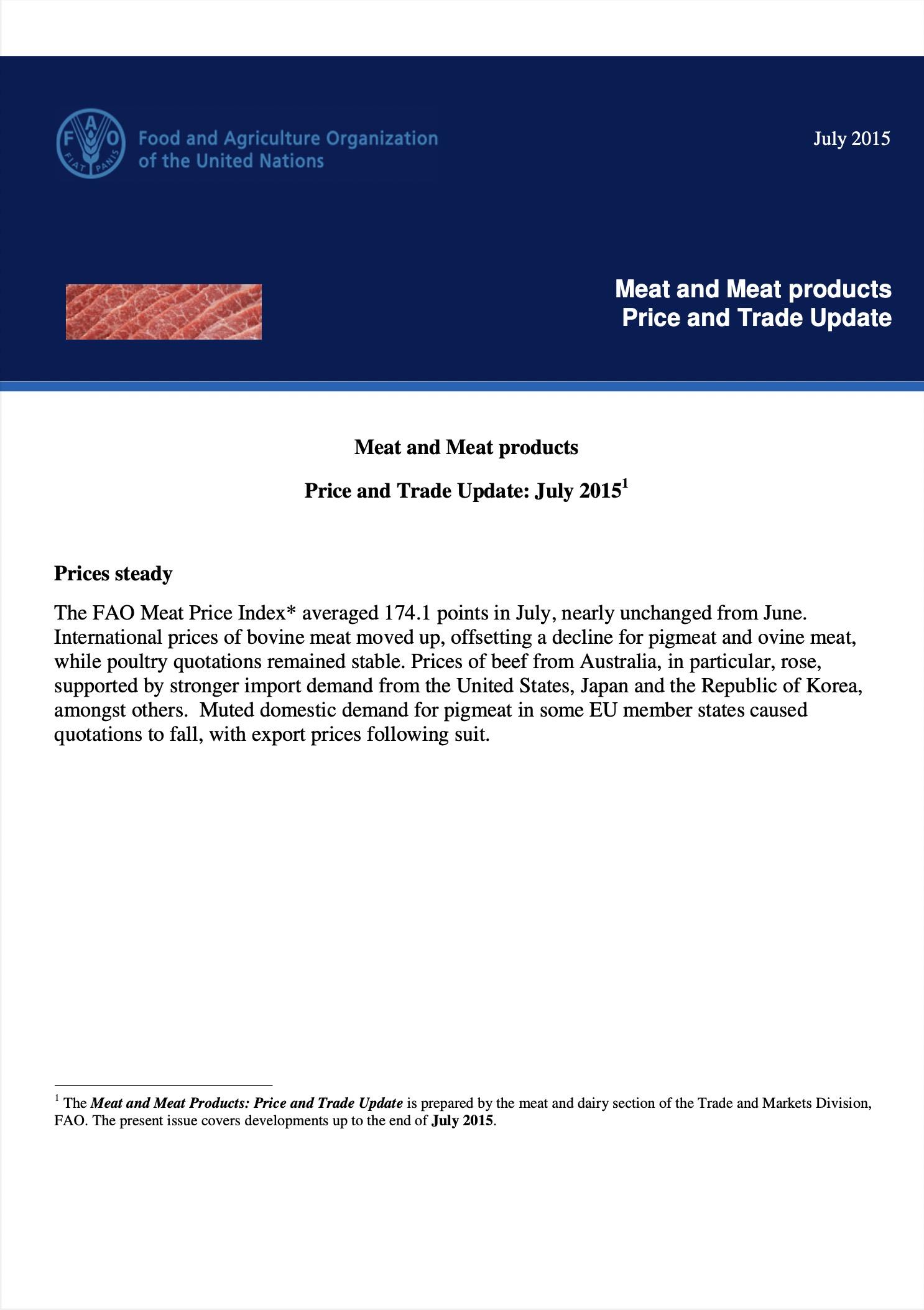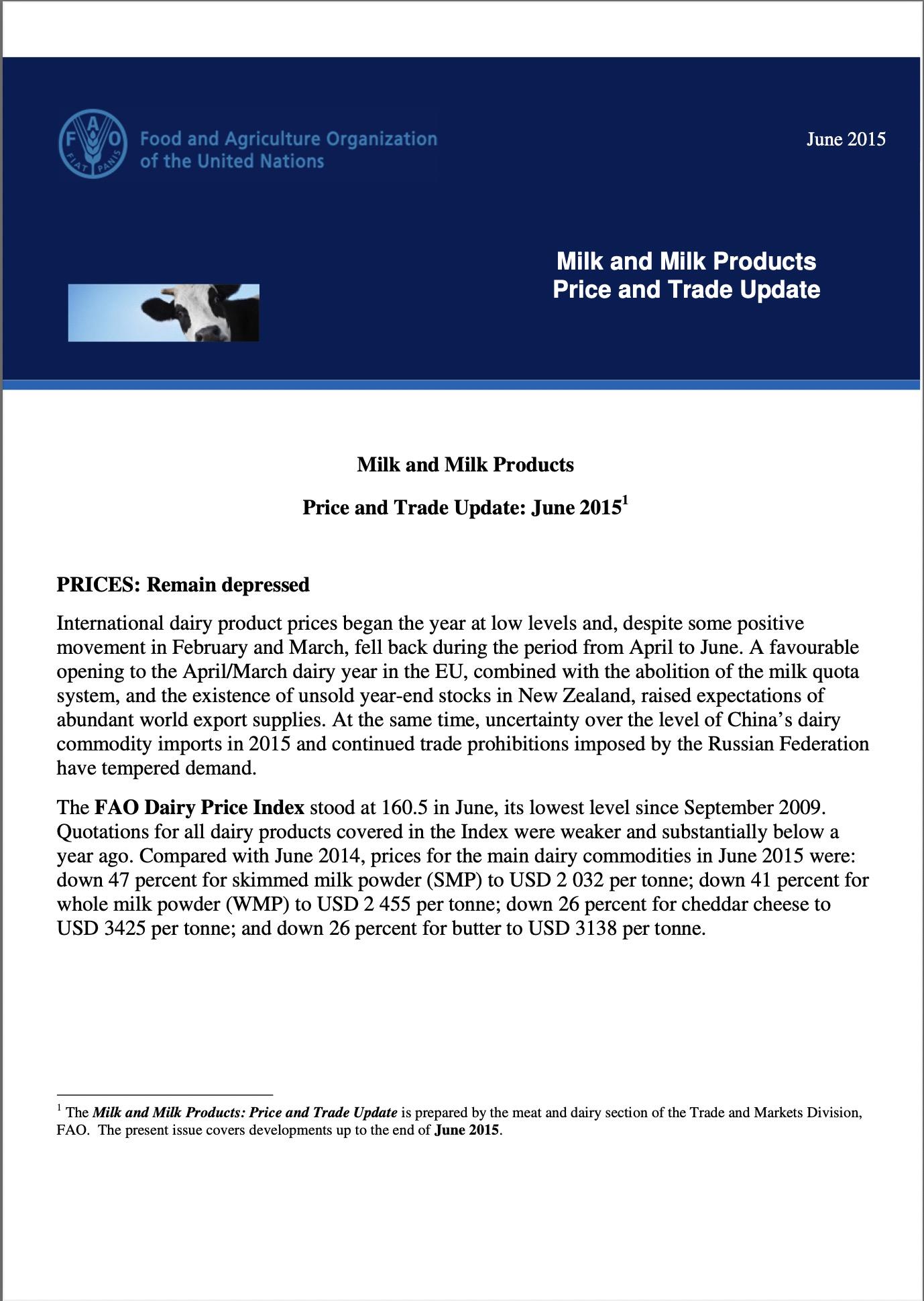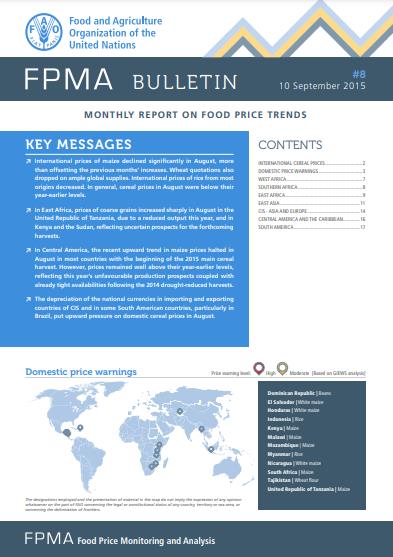
Food Price Monitoring and Analysis (FPMA) Bulletin #8, 10 September 2015
10/09/2015
International prices of maize declined significantly in August, more than offsetting the previous months’ increases. Wheat quotations also dropped on ample global supplies. International prices of rice from most origins decreased. In general, cereal prices in August were below their year‑earlier levels. In East Africa, prices of coarse grains increased sharply in August in the United Republic of Tanzania, due to a reduced output this year, and in Kenya and the Sudan, reflecting uncertain prospects for the forthcoming harvests. In Central America, the recent upward trend in maize prices halted in August in most countries with the beginning of the 2015 main cereal harvest. However, prices remained well above their year-earlier levels, reflecting this year’s unfavourable production prospects coupled with already tight availabilities following the 2014 drought-reduced harvests. The depreciation of the national currencies in importing and exporting countries of CIS and in some South American countries, particularly in Brazil, put upward pressure on domestic cereal prices in August.
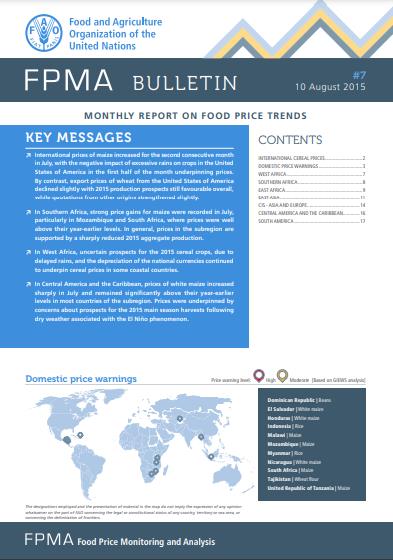
Food Price Monitoring and Analysis (FPMA) Bulletin #7, 10 August 2015
10/08/2015
International prices of maize increased for the second consecutive month in July, with the negative impact of excessive rains on crops in the United States of America in the first half of the month underpinning prices. By contrast, export prices of wheat from the United States of America declined slightly with 2015 production prospects still favourable overall, while quotations from other origins strengthened slightly. In Southern Africa, strong price gains for maize were recorded in July, particularly in Mozambique and South Africa, where prices were well above their year-earlier levels. In general, prices in the subregion are supported by a sharply reduced 2015 aggregate production. In West Africa, uncertain prospects for the 2015 cereal crops, due to delayed rains, and the depreciation of the national currencies continued to underpin cereal prices in some coastal countries. In Central America and the Caribbean, prices of white maize increased sharply in July and remained significantly above their year-earlier levels in most countries of the subregion. Prices were underpinned by concerns about prospects for the 2015 main season harvests following dry weather associated with the El Niño phenomenon.

GIEWS Update - El Niño in Asia, 29 July 2015
29/07/2015
Prolonged dry weather associated with El Niño has impaired the production outlook for the ongoing 2015 main season in several countries, including Cambodia, Democratic People’s Republic of Korea, Lao People’s Democratic Republic, the Philippines and Viet Nam. Although rains improved somewhat in the second dekad of July in parts, more rains are essential in the coming weeks to avoid a significant decrease in the 2015 cereal production in these countries.
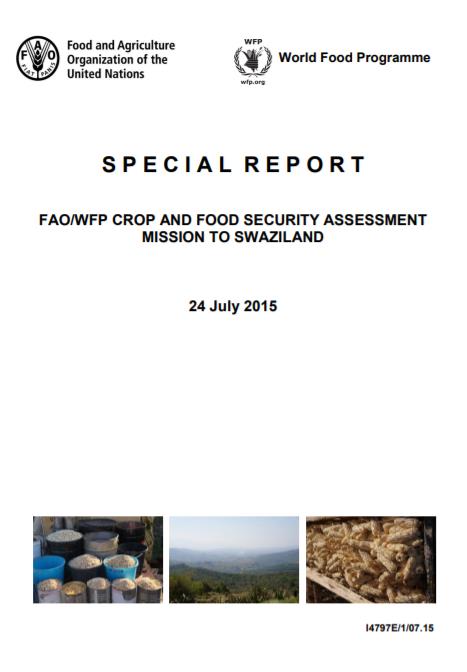
Special Report - FAO/WFP Crop and Food Security Assessment Mission to Swaziland
24/07/2015
An FAO/WFP Crop and Food Supply Assessment Mission (CFSAM) visited the country from 11 to 22 May 2015 at the invitation of the Government of Swaziland to estimate the 2014/15 maize production and assess the food security situation. The invitation was prompted by an extended dry period between January and March 2015 that had raised serious concerns over the impact on crop production, particularly in the agro-ecological zones Lowveld and Lubombo Plateau.
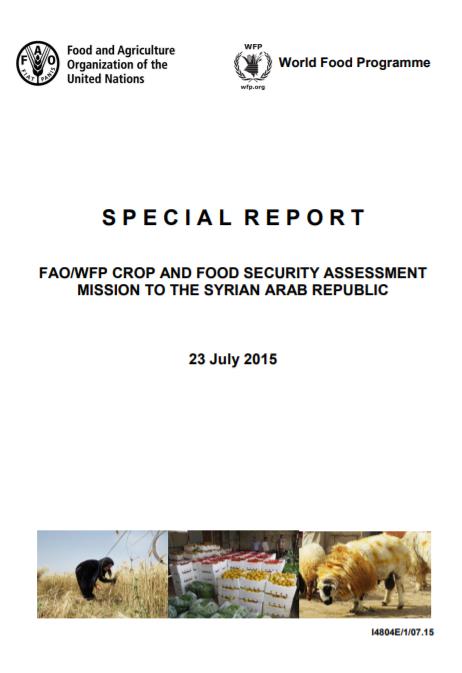
Special Report - FAO/WFP Crop and Food Security Assessment Mission to the Syrian Arab Republic - 23 July 2015
23/07/2015
Following a request to FAO from the Ministry of Agriculture and Agrarian Reform (MAAR), approved by the Ministry of Foreign Affairs (MoFA) on 17 March 2015, a joint FAO/WFP Crop and Food Security Mission (CFSAM) visited the Syrian Arab Republic between 11 and 31 May 2015.
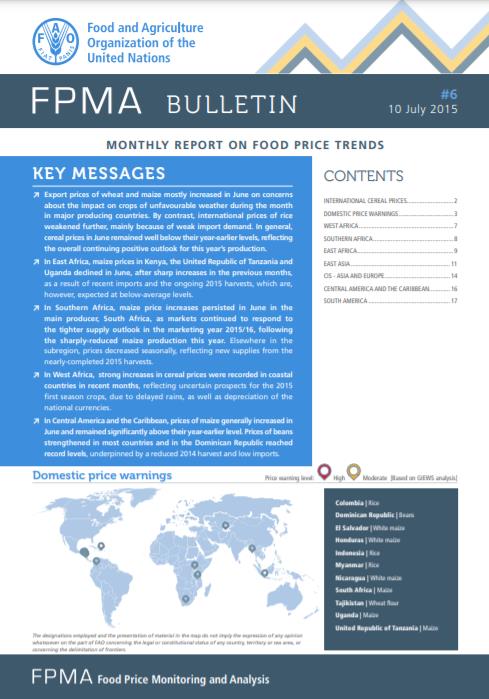
Food Price Monitoring and Analysis (FPMA) Bulletin #6, 10 July 2015
10/07/2015
Export prices of wheat and maize mostly increased in June on concerns about the impact on crops of unfavourable weather during the month in major producing countries. By contrast, international prices of rice weakened further, mainly because of weak import demand. In general, cereal prices in June remained well below their year‑earlier levels, reflecting the overall continuing positive outlook for this year’s production. In East Africa, maize prices in Kenya, the United Republic of Tanzania and Uganda declined in June, after sharp increases in the previous months, as a result of recent imports and the ongoing 2015 harvests, which are, however, expected at below‑average levels. In Southern Africa, maize price increases persisted in June in the main producer, South Africa, as markets continued to respond to the tighter supply outlook in the marketing year 2015/16, following the sharply‑reduced maize production this year. Elsewhere in the subregion, prices decreased seasonally, reflecting new supplies from the nearly‑completed 2015 harvests. In West Africa, strong increases in cereal prices were recorded in coastal countries in recent months, reflecting uncertain prospects for the 2015 first season crops, due to delayed rains, as well as depreciation of the national currencies. In Central America and the Caribbean, prices of maize generally increased in June and remained significantly above their year-earlier level. Prices of beans strengthened in most countries and in the Dominican Republic reached record levels, underpinned by a reduced 2014 harvest and low imports.
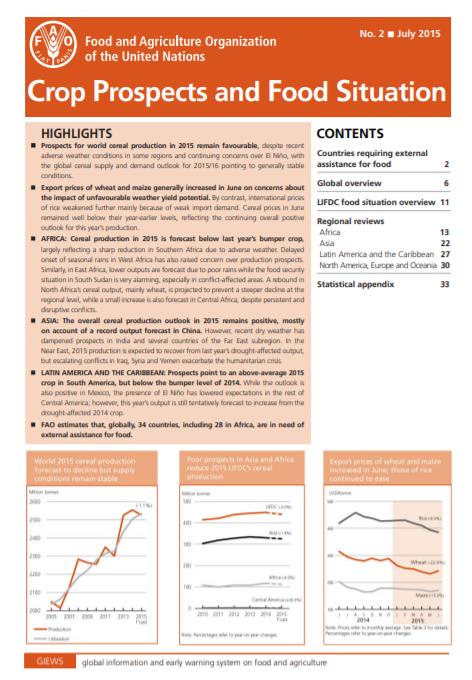
Crop Prospects and Food Situation #2, July 2015
09/07/2015
Prospects for world cereal production in 2015 remain favourable, despite recent adverse weather conditions in some regions and continuing concerns over El Niño, with the global cereal supply and demand outlook for 2015/16 pointing to generally stable conditions. Export prices of wheat and maize generally increased in June on concerns about the impact of unfavourable weather yield potential. By contrast, international prices of rice weakened further mainly because of weak import demand. Cereal pr ices in June remained well below their year-earlier levels, reflecting the continuing overall positive outlook for this year’s production.
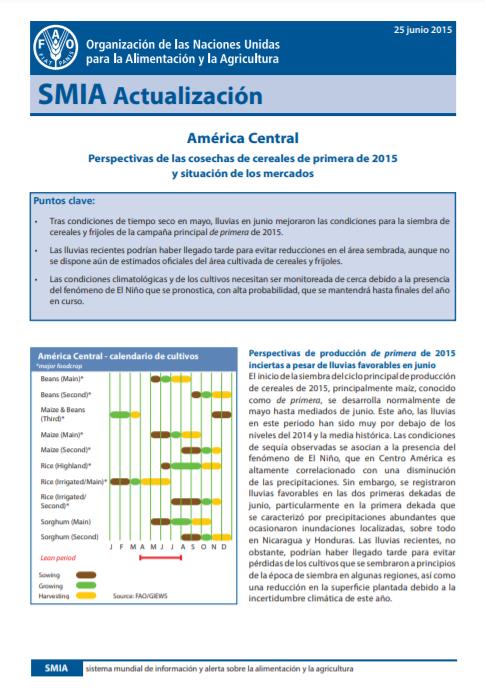
SMIA Actualización - América Central, 25 junio 2015
25/06/2015
Tras condiciones de tiempo seco en mayo, lluvias en junio mejoraron las condiciones para la siembra de cereales y frijoles de la campaña principal de primera de 2015. Las lluvias recientes podrían haber llegado tarde para evitar reducciones en el área sembrada, aunque no se dispone aún de estimados oficiales del área cultivada de cereales y frijoles. Las condiciones climatológicas y de los cultivos necesitan ser monitoreada de cerca debido a la presencia del fenómeno de El Niño que se pronosti ca, con alta probabilidad, que se mantendrá hasta finales del año en curso.
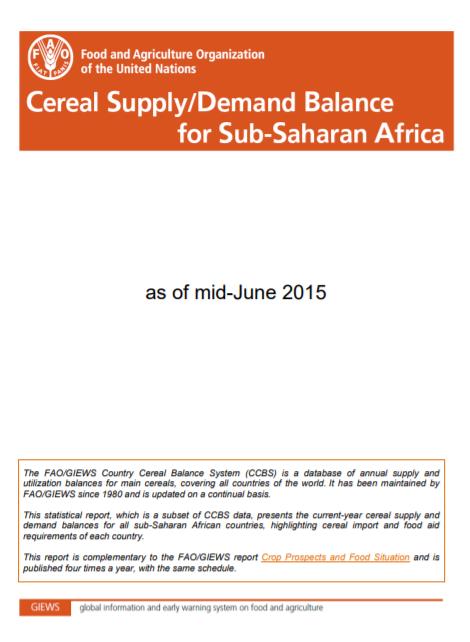
Cereal supply and demand balances for sub-Saharan African countries - No.2, June 2015
18/06/2015
The FAO/GIEWS Country Cereal Balance System (CCBS) is a database of annual supply and utilization balances for main cereals, covering all countries of the world. It has been maintained by FAO/GIEWS since 1980 and is updated on a continual basis. This statistical report, which is a subset of CCBS data, presents the current-year cereal supply and demand balances for all sub-Saharan African countries, highlighting cereal import and food aid requirements of each country. This report is complement ary to the FAO/GIEWS report Crop Prospects and Food Situation and is published four times a year, with the same schedule.
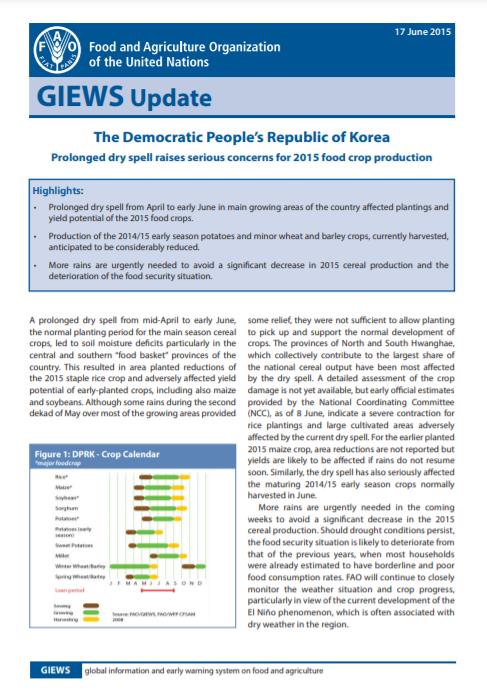
GIEWS Update - The Democratic People’s Republic of Korea, 17 June 2015
15/06/2015
Prolonged dry spell from April to early June in main growing areas of the country affected plantings and yield potential of the 2015 food crops. Production of the 2014/15 early season potatoes and minor wheat and barley crops, currently harvested, anticipated to be considerably reduced. More rains are urgently needed to avoid a significant decrease in 2015 cereal production and the deterioration of the food security situation.
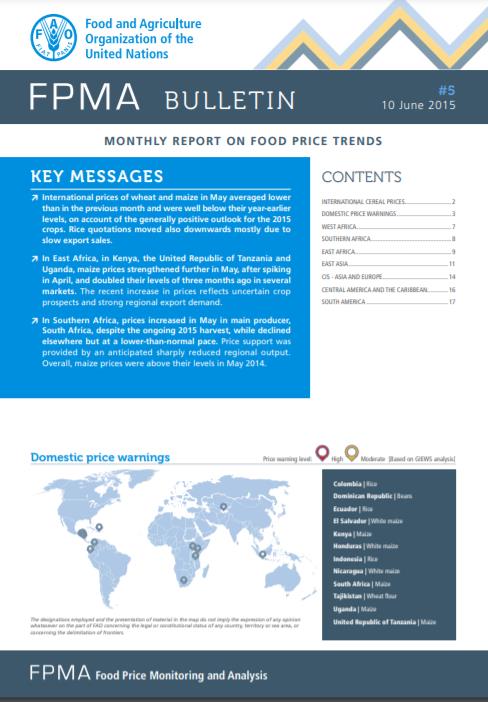
Food Price Monitoring and Analysis (FPMA) Bulletin #5, 10 June 2015
10/06/2015
International prices of wheat and maize in May averaged lower than in the previous month and were well below their year‑earlier levels, on account of the generally positive outlook for the 2015 crops. Rice quotations moved also downwards mostly due to slow export sales. In East Africa, in Kenya, the United Republic of Tanzania and Uganda, maize prices strengthened further in May, after spiking in April, and doubled their levels of three months ago in several markets. The recent increase in prices reflects uncertain crop prospects and strong regional export demand. In Southern Africa, prices increased in May in main producer, South Africa, despite the ongoing 2015 harvest, while declined elsewhere but at a lower-than-normal pace. Price support was provided by an anticipated sharply reduced regional output. Overall, maize prices were above their levels in May 2014.
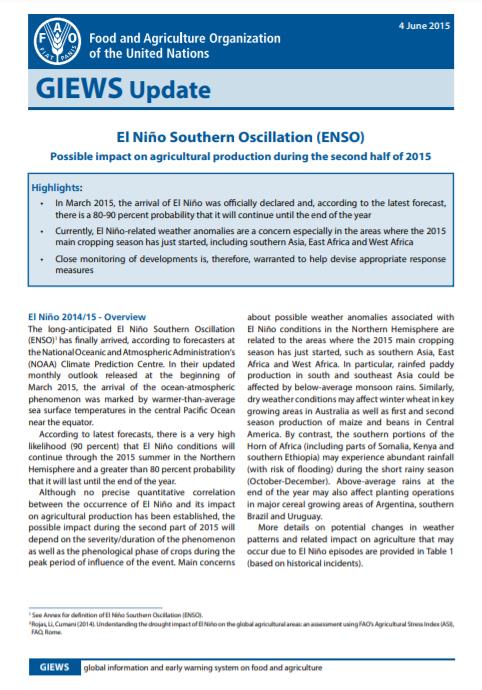
GIEWS Update - El Niño Southern Oscillation (ENSO), 4 June 2015
04/06/2015
In March 2015, the arrival of El Niño was officially declared and, according to the latest forecast, there is a 80-90 percent probability that it will continue until the end of the year. Currently, El Niño-related weather anomalies are a concern especially in the areas where the 2015 main cropping season has just started, including southern Asia, East Africa and West Africa. Close monitoring of developments is, therefore, warranted to help devise appropriate response measures.
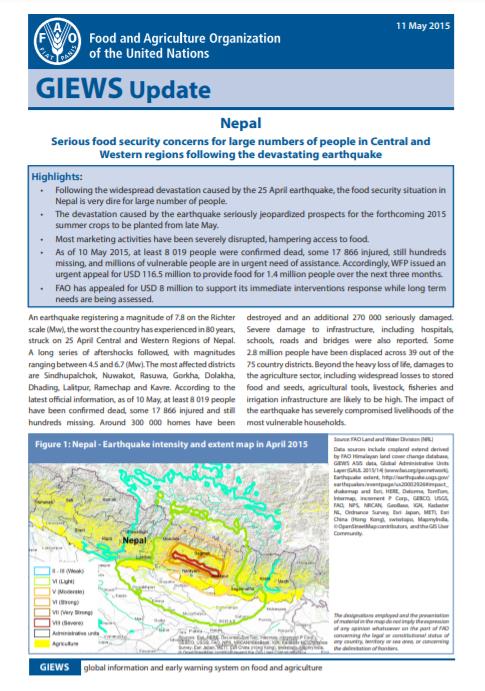
GIEWS Update - Nepal, 11 May 2015
11/05/2015
Following the widespread devastation caused by the 25 April earthquake, the food security situation in Nepal is very dire for large number of people. The devastation caused by the earthquake seriously jeopardized prospects for the forthcoming 2015 summer crops to be planted from late May. Most marketing activities have been severely disrupted, hampering access to food.
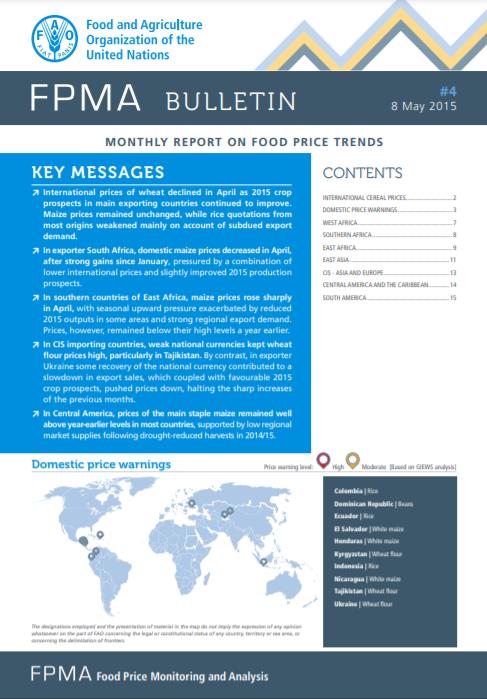
Food Price Monitoring and Analysis (FPMA) Bulletin #4, 8 May 2015
08/05/2015
International prices of wheat declined in April as 2015 crop prospects in main exporting countries continued to improve. Maize prices remained unchanged, while rice quotations from most origins weakened mainly on account of subdued export demand. In exporter South Africa, domestic maize prices decreased in April, after strong gains since January, pressured by a combination of lower international prices and slightly improved 2015 production prospects. In southern countries of East Africa, maize prices rose sharply in April, with seasonal upward pressure exacerbated by reduced 2015 outputs in some areas and strong regional export demand. Prices, however, remained below their high levels a year earlier. In CIS importing countries, weak national currencies kept wheat flour prices high, particularly in Tajikistan. By contrast, in exporter Ukraine some recovery of the national currency contributed to a slowdown in export sales, which coupled with favourable 2015 crop prospects, pushed prices down, halting the sharp increases of the previous months. In Central America, prices of the main staple maize remained well above year-earlier levels in most countries, supported by low regional market supplies following drought-reduced harvests in 2014/15.
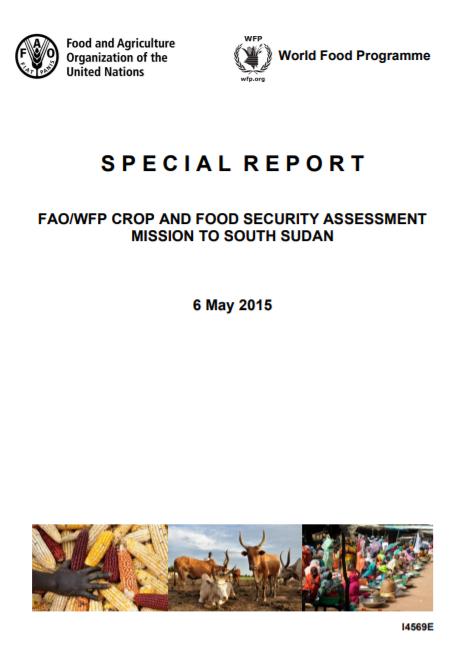
Special Report - FAO/WFP Crop and Food Security Assessment Mission to South Sudan - 6 May 2015
06/05/2015
An FAO/WFP Crop and Food Security Assessment Mission (CFSAM) visited South Sudan from 2 to 14 February 2015 to estimate cereal production during 2014 and assess the overall food security situation. Although there have been notable improvements relative to the first half of 2014, the food security perspectives during 2015 remain a cause for concern. Even though households in non-conflict areas have larger stocks as a result of the 2014 good harvest, states neighbouring the conflict areas still re gister high rates of food insecurity. In 2015, WFP plans to assist 3 million people in South Sudan providing just under 261 000 tonnes of food, depending on levels of funding; though a large component (1.4 million) concerns people directly affected by conflict, WFP assistance will also focus on school feeding, nutrition interventions and food for assets programmes.
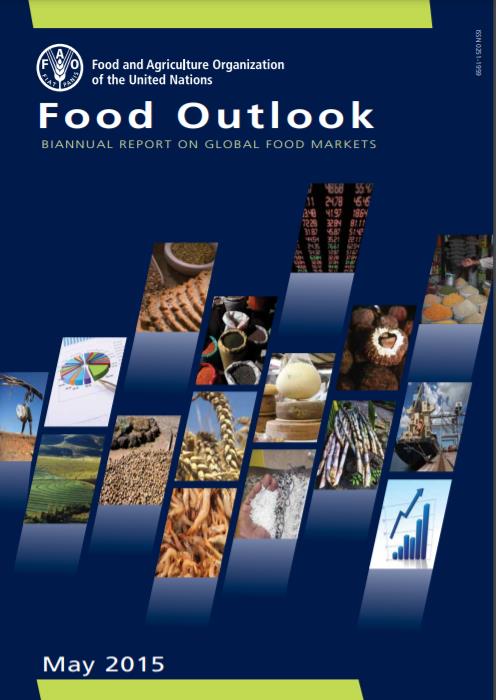
Food Outlook - May 2015
04/05/2015
Food Outlook is published by the Trade and Market Division of FAO under Global Information and Early Warning System (GIEWS). It is a biannual publication focusing on developments affecting global food and feed markets. Each report provides comprehensive assessments and short term forecasts for production, utilization, trade, stocks and prices on a commodity by commodity basis and includes feature articles on topical issues. Food Outlook maintains a close synergy with another major GIEWS publicat ion, Crop Prospects and Food Situation, especially with regard to the coverage of cereals. Food outlook is available in English. The summary section is also available in Arabic, Chinese, French, Spanish and Russian.
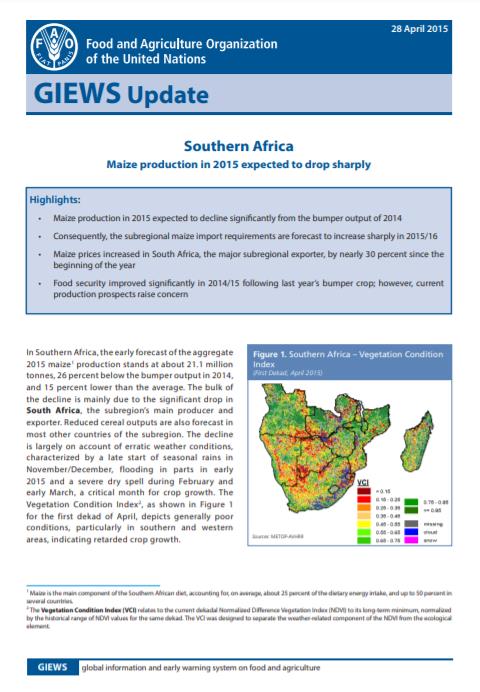
GIEWS Update - Southern Africa, 28 April 2015
28/04/2015
Maize production in 2015 expected to decline significantly from the bumper output of 2014. Consequently, the subregional maize import requirements are forecast to increase sharply in 2015/16. Maize prices increased in South Africa, the major subregional exporter, by nearly 30 percent since the beginning of the year. Food security improved significantly in 2014/15 following last year’s bumper crop; however, current production prospects raise concern.
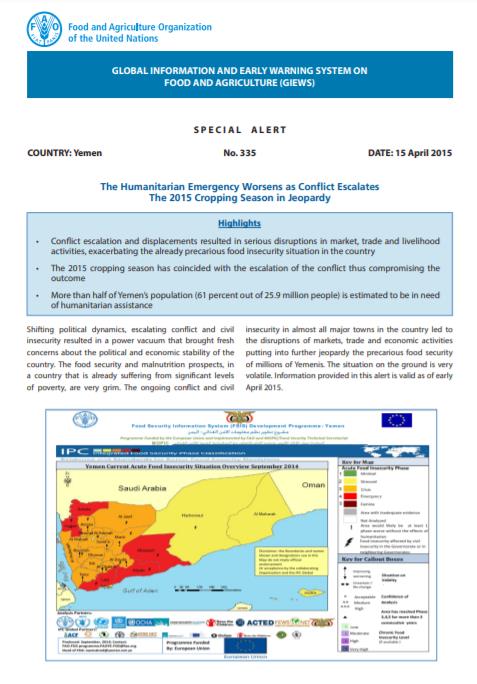
GIEWS Special Alert No. 335 - Yemen, 15 April 2015
15/04/2015
Conflict escalation and displacements resulted in serious disruptions in market, trade and livelihood activities, exacerbating the already precarious food insecurity situation in the country. The 2015 cropping season has coincided with the escalation of the conflict thus compromising the outcome. More than half of Yemen’s population (61 percent out of 25.9 million people) is estimated to be in need of humanitarian assistance.

